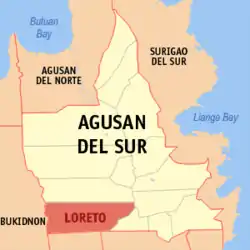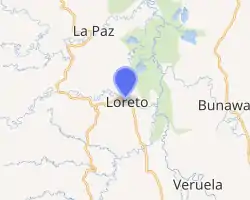Loreto, Agusan del Sur
Loreto, officially the Municipality of Loreto (Cebuano: Lungsod sa Loreto; Tagalog: Bayan ng Loreto), is a 1st class municipality in the province of Agusan del Sur, Philippines. According to the 2015 census, it has a population of 42,501 people. [3]
Loreto | |
|---|---|
| Municipality of Loreto | |
 Map of Agusan del Sur with Loreto highlighted | |
OpenStreetMap 
| |
.svg.png.webp) Loreto Location within the Philippines | |
| Coordinates: 8°11′N 125°51′E | |
| Country | |
| Region | Caraga (Region XIII) |
| Province | Agusan del Sur |
| District | 2nd District |
| Founded | March 30, 1965 |
| Barangays | 17 (see Barangays) |
| Government | |
| • Type | Sangguniang Bayan |
| • Mayor | Lorife M. Otaza |
| • Vice Mayor | Randolph B. Plaza |
| • Representative | Adolph Edward G. Plaza |
| • Electorate | 25,086 voters (2019) |
| Area | |
| • Total | 1,462.74 km2 (564.77 sq mi) |
| Elevation | 335 m (1,099 ft) |
| Population | |
| • Total | 42,501 |
| • Density | 29/km2 (75/sq mi) |
| • Households | 8,947 |
| Economy | |
| • Income class | 1st municipal income class |
| • Poverty incidence | 49.01% (2015)[4] |
| • Revenue | ₱256,405,187.05 (2016) |
| Time zone | UTC+8 (PST) |
| ZIP code | 8507 |
| PSGC | |
| IDD : area code | +63 (0)85 |
| Climate type | tropical rainforest climate |
| Native languages | Agusan Butuanon Cebuano Higaonon Tagalog |
History
It was in the year 1600 (please check this date, Fr. Urios came to Agusan in the 1880s) when the Spaniards first came to the upper reaches of Agusan and discovered the Manobos. In convincing the Manobos to organise themselves and live in a settlement/community, the settlement was given the name of "Loreto" in remembrance of Fr. Urios town in Spain on March 30, 1965.
Rain of fish
On a rainy morning on January 13, 2012, Loreto became nationally notable when it became the site of a rain of fish. Seventy-two small fish were recovered and placed in an aquarium. They were about 3 in (7.6 cm) long and had small spots, but the species remains unknown. The Bureau of Fisheries and Aquatic Resources attributes the phenomenon to a waterspout.[5][6][7]
Geography
Loreto is located at 8°11′N 125°51′E.
According to the Philippine Statistics Authority, the municipality has a land area of 1,462.74 square kilometres (564.77 sq mi) [2] constituting 14.64% of the 9,989.52-square-kilometre- (3,856.98 sq mi) total area of Agusan del Sur.
Loreto is a river town situated south-west of Agusan del Sur. It is bounded on the north by La Paz, north-east by Bunawan, and southeast by Veruela. The provinces of Bukidnon and Davao del Norte bound its Western and Southern portions.
Loreto is a strategically situated as a junction point to various destination within Agusan del Sur and nearby provinces. The accessibility of Loreto to Provincial Center, Patin-ay in Prosperidad has three main routes: the Loreto-Santa Josefa-Trento route of 118.36 kilometres (73.55 mi), the Loreto-La Paz Talacogon route of 85.53 kilometres (53.15 mi), and the Loreto-Bunawan route of 87.52 kilometres (54.38 mi) with two hours of Pump boat cruising the Agusan River.
Climate
| Climate data for Loreto, Agusan del Sur | |||||||||||||
|---|---|---|---|---|---|---|---|---|---|---|---|---|---|
| Month | Jan | Feb | Mar | Apr | May | Jun | Jul | Aug | Sep | Oct | Nov | Dec | Year |
| Average high °C (°F) | 27 (81) |
27 (81) |
28 (82) |
30 (86) |
30 (86) |
30 (86) |
30 (86) |
30 (86) |
30 (86) |
30 (86) |
29 (84) |
28 (82) |
29 (84) |
| Average low °C (°F) | 23 (73) |
23 (73) |
22 (72) |
23 (73) |
24 (75) |
24 (75) |
24 (75) |
24 (75) |
24 (75) |
24 (75) |
23 (73) |
23 (73) |
23 (74) |
| Average precipitation mm (inches) | 105 (4.1) |
72 (2.8) |
55 (2.2) |
40 (1.6) |
69 (2.7) |
94 (3.7) |
100 (3.9) |
103 (4.1) |
99 (3.9) |
106 (4.2) |
85 (3.3) |
63 (2.5) |
991 (39) |
| Average rainy days | 17.6 | 16.0 | 14.9 | 14.0 | 20.9 | 24.3 | 25.3 | 25.5 | 24.5 | 24.7 | 19.7 | 16.7 | 244.1 |
| Source: Meteoblue [8] | |||||||||||||
Barangays
Loreto is politically subdivided into 17 barangays.[9]
| PSGC | Barangay | Population | ±% p.a. | |||
|---|---|---|---|---|---|---|
| 2015 [3] | 2010 [10] | |||||
| 160305001 | Binucayan | 6.5% | 2,781 | 3,605 | −4.82% | |
| 160305002 | Johnson | 3.4% | 1,433 | 1,547 | −1.45% | |
| 160305013 | Kasapa | 4.1% | 1,738 | 3,122 | −10.55% | |
| 160305014 | Katipunan | 1.2% | 525 | 677 | −4.73% | |
| 160305015 | Kauswagan | 5.8% | 2,445 | 2,182 | 2.19% | |
| 160305003 | Magaud | 7.8% | 3,314 | 2,303 | 7.18% | |
| 160305004 | Nueva Gracia | 5.3% | 2,270 | 1,928 | 3.16% | |
| 160305005 | Poblacion | 15.0% | 6,384 | 6,456 | −0.21% | |
| 160305017 | Sabud | 10.3% | 4,367 | 779 | 38.85% | |
| 160305006 | San Isidro | 3.8% | 1,601 | 1,532 | 0.84% | |
| 160305007 | San Mariano | 5.7% | 2,411 | 2,709 | −2.19% | |
| 160305008 | San Vicente | 5.1% | 2,163 | 2,227 | −0.55% | |
| 160305009 | Santa Teresa | 5.5% | 2,325 | 2,324 | 0.01% | |
| 160305016 | Santo Niño | 2.6% | 1,088 | 1,221 | −2.17% | |
| 160305010 | Santo Tomas | 9.1% | 3,859 | 3,674 | 0.94% | |
| 160305011 | Violanta | 3.4% | 1,439 | 1,174 | 3.95% | |
| 160305012 | Waloe | 5.5% | 2,358 | 2,014 | 3.05% | |
| Total | 42,501 | 39,474 | 1.42% | |||
Demographics
| Year | Pop. | ±% p.a. |
|---|---|---|
| 1918 | 2,447 | — |
| 1939 | 4,395 | +2.83% |
| 1948 | 4,125 | −0.70% |
| 1960 | 6,248 | +3.52% |
| 1970 | 13,057 | +7.64% |
| 1975 | 16,264 | +4.50% |
| 1980 | 18,781 | +2.92% |
| 1990 | 21,133 | +1.19% |
| 1995 | 24,022 | +2.43% |
| 2000 | 31,365 | +5.88% |
| 2007 | 34,549 | +1.34% |
| 2010 | 39,474 | +4.97% |
| 2015 | 42,501 | +1.42% |
| Source: Philippine Statistics Authority [3] [10] [11][12] | ||
In the 2015 census, Loreto had a population of 42,501. [3] The population density was 29 inhabitants per square kilometre (75/sq mi).
References
- Municipality of Loreto | (DILG)
- "Province: Agusan del Sur". PSGC Interactive. Quezon City, Philippines: Philippine Statistics Authority. Retrieved 12 November 2016.
- Census of Population (2015). "Caraga". Total Population by Province, City, Municipality and Barangay. PSA. Retrieved 20 June 2016.
- "PSA releases the 2015 Municipal and City Level Poverty Estimates". Quezon City, Philippines. Retrieved 12 October 2019.
- Jereco O. Paloma (January 15, 2012). "Agusan's 'rain of fish' natural although unusual". SunStar Davao. Archived from the original on August 26, 2014. Retrieved January 16, 2012.
- Lani Nami Buan (January 15, 2012). "'Fish rain' puzzles residents in Agusan Sur's Loreto town". GMA News. Retrieved January 16, 2012.
- Charmane Awitan (January 13, 2012). "Fish rain down on Agusan del Sur town". ABS-CBN News. Retrieved January 16, 2012.
- "Loreto: Average Temperatures and Rainfall". Meteoblue. Retrieved 29 April 2020.
- "Municipal: Loreto, Agusan del Sur". PSGC Interactive. Quezon City, Philippines: Philippine Statistics Authority. Retrieved 8 January 2016.
- Census of Population and Housing (2010). "Caraga". Total Population by Province, City, Municipality and Barangay. NSO. Retrieved 29 June 2016.
- Censuses of Population (1903–2007). "Caraga". Table 1. Population Enumerated in Various Censuses by Province/Highly Urbanized City: 1903 to 2007. NSO.
- "Province of Agusan del Sur". Municipality Population Data. Local Water Utilities Administration Research Division. Retrieved 17 December 2016.